Introduction
Background to the study
In the last ten years, there has been a change in emphasis from learning to performance support in organizations. Performance support is the term used to depict anything that empowers people to effectively complete tasks or undertakings without depending too much on other individuals, and training departments having transformed into learning and development department are progressively coordinating the idea of performance support into their trappings and procedures (McDermott, 1999, p. 104).
Conventional training departments are persistently being approached to account for how different learning initiatives and procedures add value to the business. Training and development functions, with the aim of providing performance backing, are utilizing technological advancements and apparatuses to convey content and assess learning in a more compelling manner for both the learner and the organization. The instructors are turning out to be more predominant and noticeable and are extending the learning and development function to beyond simply conveying instructional components. They are relating investment in learning and development to the execution and achievement of the general business policy (Vera & Crossam, 2003, p. 21).
Spirgi and Gebavi (2007) stated that it is uncommon to have the learning and development function completely incorporated into one division. Most associations have a corporate learning and development group in charge of business-wide training (for example, leadership development and project management), and specialized or well-designed training expert or divisions that are integrated into the business.
This sort of devolved model is prevalent and proficient (Spirgi & Gebavi, 2007, p. 34). The research and development function likewise regularly dwells in the HR structure and is generally seen to be responsible for the design, execution and assessment of prescribed training programs. The majority of these training are instructor driven and classroom-oriented (Vera & Crossam, 2003, p. 23).
In the recent past, there has been an increasing pressure for learning and development to leverage current information and communication technologies so that training and learning can take place through various conveyance techniques and in substantially less formal setting than a tutorial room (Vera & Crossam, 2003, p. 23). The developments in web innovation, combined with cutting edge visual designs and applications, have led to the introduction of web-based training (also referred to as e-learning). E-learning has become more popular owing to the fact that it can propagate training to a large number of people in an appealing but also in a more financially savvy and proficient way, when the conditions are spot-on (Rosenberg, 2001, p. 97).
Elements such as organization’s specialized framework, organizational culture and enthusiasm, the rate of embracing new innovation, management support and so forth all define the success of web-based training in organizations.
The role of the learning and development is progressively centered on how to tap web-based learning and constantly enhancing technologies in a manner that conveys significant learning encounters to the individuals, groups, and associations (Schein, 1993, p. 48).
Information and communication departments are in charge of keeping up with the latest innovation patterns and devising novel tools and frameworks available to the organization. The approval and use of the new technologies, in any case, relies upon various functions with the organization (Spirgi & Gebavi, 2007, p. 35). It is the learning and development function’s obligation not to just comprehend what these novel technologies are, but also to utilize them and incorporate them into the existing model and conveyance of knowledge content.
The learning and development department plays a key role in modeling coveted conduct and involves others in learning to improve performance (Spirgi & Gebavi, 2007, p. 36).
Learning and development through knowledge management system are turning into a key weapon for power and energy companies in the current information-driven markets. As indicated by Serban & Luan (2002), there are numerous success stories of companies that have achieved competitive advantage through effective knowledge management. They define knowledge management as an array of methodologies utilized by companies to acquire the correct information and pass it to the right individual at the right time. It also describes the process where a company completely assembles, methodically share and assesses its knowledge which has been categorized as human resource, reports, and other basic assets relevant in accomplishing organizational goals and objectives (Chong & Besharati, 2014, P. 171).
E-learning needs systems that consider such intricacies as course level complications, whether the essential requirements have been met by the learner, and whether the learner acquires the right information or content through the system (Robertson, 2003, p. 7). Robertson (2003, p. 7) reinforces the notion that the main objective of knowledge management system is to offer an integrated repository for a limited volume of information for easy retrieval, amendment, and delivery. He argues that the most significant aspect of knowledge system management is the content itself.
The main obstacle to learning and development in most companies is the presence of weak/unfavorable organizational culture. They classify obstacles to knowledge building into three categories, namely: individual (persons), hierarchical, and technological obstacles. In order for learning to be successful, these obstacles should be incorporated in a manner that they supplement each other. Nevertheless, there are many other obstacles and impediments that each and every organization must tackle so as to take full advantage of the new system of learning (Chong & Besharati, 2014, P. 174).
Take a case of power and energy companies which are operating in a knowledge-intensive industry where there are numerous challenges that impact their access to greatly valued information. In addition, there are other challenges like performance improvement in the dangerous and costly ventures, creating a client-based knowledge base, minimizing capital expenditure and overhead costs, enhancing usage and uptime, and effective market positioning in the international market (Tucci, 2013).
Problem Statement
Conventional classroom training is no longer the only area that organizational learning emphasizes on, and the change from prescribed customary strategies for training to mixed methodologies utilizing innovation and combined systems has placed learning and development functions in a different turf (Spirgi & Gebavi, 2007, p. 36). Regardless of the value that learning and development fetches, during difficult times, organizations often consider transient cost cutting measures and in many occasions do away with or hold back learning and development initiatives.
The main test then turns out to be the means by which to preserve knowledge and sustain learning in these settings, and how to keep individuals posted with constrained resources and time (Chong & Besharati, 2014, P. 173).
In addition, whereas the technology and instruments might be accessible, the usage and incorporation into the organization’s values and principles is a process that requires an organizational learning curve on the off chance that individuals in the organization are not acquainted with this type of learning. For organizations that do not have extremely entrenched values and principles of learning and development, the problems in the organization are amplified, and distinct objectives and assessment techniques need to pinpoint the effect of such programs in the association (Schein, 1993, p. 43).
In power and energy companies, the main obstacle to learning and development, as well as knowledge management is organizational culture. Their corporate cultures more often than not do not promote knowledge sharing practices (Tucci, 2013).
These companies also deal with numerous intricate tasks that are considered knowledge-intensive. However, globalization, subcontracting, advanced technologies, new partnerships, and government policies have enhanced the need for knowledge sharing practices for speedier and enriched work procedures (Chong & Besharati, 2014, P. 177). It is because of these developments that the study aims to explore the various initiatives that power and energy companies in Saudi Arabia are undertaking to enhance knowledge management system and information sharing.
Significance of the research
The significance of the study will include but not limited to the following:
- The study results will assist power and energy companies in Saudi Arabia to develop effective learning organization through knowledge management system.
- The findings of the study will also assist the policymakers in coming up with new ways of enhancing knowledge management in the power and energy sector.
Research Purpose and Rationale
The purpose of this study is to explore various initiatives that power and energy companies in Saudi Arabia are undertaking to enhance knowledge management system. This study is essential in the way that it adds to the existing knowledge in the field of knowledge management, particularly in power and energy companies in Saudi Arabia. The eventual outcomes of this study are extremely important to the business administrators in light of the way that they can use it for attracting and retaining key talent.
Research Objectives
The primary objective of this research is to establish an effective learning organization for power and energy companies in Saudi Arabia through knowledge management system. In accordance with this, the specific objectives are:
- To determine the impact of training and development on knowledge management system.
- To establish the relationship between enhanced communication and collaboration and knowledge management system.
- To find out the effect of effective knowledge performance on knowledge management.
- To determine the significance of increased leadership capability on knowledge management.
- To find out whether learners-focused strategy affects knowledge management.
- Lastly, to discover the impact of expanding knowledge and authority on knowledge management system.
Research questions
The above research objectives will be assessed by taking into consideration the following research question.
What is the role of various corporate initiatives on knowledge management systems in power and energy companies in Saudi Arabia?
Research Hypothesis
The paper is based on the following research hypotheses to achieve the research objective.
- There is a high correlation between training and development and knowledge management system.
- Enhanced communication and collaboration is the cornerstone of knowledge management system.
- Organizational learning through knowledge management system cannot be achieved without effective knowledge performance.
- Increased leadership capability is directly linked to knowledge management system.
- Learning organization through knowledge management system significantly depends on learner-focused strategy.
- Lastly, expanding knowledge and authority plays a key role in the establishment of new systems of learning.
Limitations of the study
Limitations allude to confinements that the investigator has no influence over. There may be stresses on additional budgetary expenses for gathering the data, paying little regard to whether the gathered data is genuinely affirmed or not. Additionally, a couple of agents may be reluctant to offer a few information they regard confidential and could jeopardize their relationship with the association’s executives. The nature of work and the bustling calendar by the top administration as respondents led to questionnaires not being filled in time.
To avert the first limitation of the study was to strictly adhere to the budget. The second confinement was averted by guaranteeing the respondents that the data they gave will be dealt with extreme secrecy. The third confinement was avoided by drawing in the respondents in a brief meeting before issuing them with the survey as a procedure to improve participation.
Literature Review
Theoretical Framework
History of Learning Management System (LMS)
Learning Management System is an automated pedestal that can be utilized to dispatch and track electronic learning and improve personalized training through network components (Tubaishat, 2008, p. 41). Learning Management Systems have evolved contrastingly for formal and corporate training to address diverse issues (Spirgi & Gebavi, 2007, p. 35). The most widely recognized frameworks utilized as a part of instruction are WebCT, Blackboard, and Moodle (Tubaishat, 2008, p. 41).
They are regularly referred to as course administration frameworks. This term is often confused with content administration framework. Therefore, learning management system is applicable to both educational and corporate setting. In most cases, the two are usually identified as corporate LMS and educational LMS. The latter is commonly referred to as virtual learning environment (VLE) (Tubaishat, 2008, p. 41).
The objective of making education simpler, superior and speedier through computerization has been around for many years. The history of learning management system started in the early 20th century with basic devices that looked like typewriters to very complex cloud-based systems. The evolutionary history of learning management system is narrowly linked to the advancement of digital technologies and the World Wide Web. Each breakthrough in the learning management system’s history was manifested by a development that enhanced speedy transfer of knowledge and self-directed learning (Martin, 2009, p. 2).
The first milestone in LMS history was in 1924 when a lecturer at Ohio State University invented a learning device that looked like the typewriter and could be utilized for giving instructions and administering multiple-choice questions. In 1945, Vannevar Bush, an engineer/innovator, came up with an enhanced memory machine known as “memex”. The machine could store information that was speedily and easily accessible. The machine is credited for the development of hypertext, the networking process that is the core of the World Wide Web (Martin, 2009, p. 3).
In 1965, the self-adaptive keyboard instructor was invented by Gordon Pask and McKinnon Wood to assist in enhancing typing speed and precision. This was the first adaptive instructional system, which imitated the instructor-student relation (Martin, 2009, p. 4).
Nine years later the first computer-based teaching program known as PLATO was presented by the University of Illinois. PLATO stands for Programmed Logic for Automated Teaching Operation. It was a host to the initial web-based community. In the late 1960s, the U.S. Department of Defense commissioned the advanced research project agency network (ARPANET), which came up with numerous protocols that were later utilized in the World Wide Web (Tubaishat, 2008, p. 46).
One of the greatest milestones in the history of LMS is the commissioning of Project Athena by the Massachusetts Institute of Technology in 1983. The eight-year project produced many computer-based educational tools that permit third party instructional programs to be incorporated into the course (Tucci, 2013, p. 11). The first LMS class was held in 1990 following the introduction of “First Class” by Soft-Arc. This program was tailored for Apple Macintosh instead of a mainframe computer. The UK’s Open University used the program to convey web-based learning all over Europe (Tucci, 2013, p. 12).
In 1997, Course Info developed an Interactive Learning Network, which is the first LMS to utilize the relational MySQL database. The network was set up in a number of universities, including Yale and Cornell. The present LMS standards are based on the SCORM 2004. SCORM refers to Shareable Content Object Reference Mode (Tubaishat, 2008, p. 46). The cloud-based LMS program was released in 2008. The program was known as the Eucalyptus which was the first API to be deployed in a private cloud. API stands for application programming interface. Eucalyptus enabled LMS to runs exclusively online without installing it on the PC or in-house network (Martin, 2009, p. 14).
Last but not least, the up-to-the-minute LMS is the SaaS Learning Management System which takes full advantage of cloud technology. Cloud technology is a term that is coined from the way the wide area network and the Internet have been drawn as a cloud in the network diagrams. To be specific, cloud technology is a system that facilitates shared computing resources with the potential for expendable enterprise scalability and on-demand provision. The term resources refer to networks, servers, applications, services and storage with easier provision and release. The SaaS Learning Management System has freed companies from the cost of setting up internal systems (Martin, 2009, p. 18).
Types of Learning Management Systems
There are countless types of Learning Management Systems utilized by companies to facilitate learning and to convey course material to workers. Given the fact that these frameworks ordinarily share mutual objective, which is to oversee and manage educational modules to an extensive and in some cases distributed personnel, the components of each of these systems varies considerably (Coates, 2007, p. 213). When picking a Learning Management System, a lot of consideration should be given to the means of delivering the course content to the end users. In addition, the system should match the needs and the budget of the organization (Tucci, 2013, p. 3).
There are even free learning administration frameworks, for example, open source programming that by description are unreservedly accessible for use and can be adjusted to match specific needs. Numerous clients of open source programming often make improvements or utilize add-ons to match specific needs Open source Learning Management System can progress very fast on the off chance that they receive adequate attention and input.
Whereas it is not likely for the end-user to get formal support for an open source LMS, there is always a robust on-line community with various forums where an individual can request for or provide assistance (Mizra & Al-Addulkareem, 2016, p. 83).
Obviously, there are also commercial categories of learning administration frameworks. Most commercial types of LMS are more robust, well documented and have an excellent level of support. Furthermore, they are more stable and free of viruses, but there are few exceptions (Mizra & Al-Addulkareem, 2016, p. 83). The commercial versions can either be deployed solution system or hosted system. Deployed solution systems have vendor developed programs and are generally installed on the company’s own server.
They are relatively expensive because the company has to incur the cost of setting up the system internally or in-house. Additional costs include costs of maintenance, the cost of hiring a support team, and exorbitant power bill due to increased ICT infrastructure (Mizra & Al-Addulkareem, 2016, p. 84).
Hosted systems are web-based. For this system, a lot of work and expenses are taken off the hands of the end-user because the system runs on the service provider’s server. The end-user only has control over the application on a pay as you use rate, and is not responsible for set up and maintenance (Mizra & Al-Addulkareem, 2016, p. 84). SaaS Learning Management System is an example of a hosted system. SaaS denotes Software as a Service, which basically means that the user has the ability to access the applications over a network for a fee (Gorelik, 2013, p. 8).
What is Content Management?
This is an arrangement of procedures and advancements that support the gathering, administration, and distribution of information in any structure or medium (Rockley, 2002, p. 12). When stored and retrieved through computers, the information is often known as digital content. The content may be in the form of texts audiovisual records, or some other record that takes after a content lifecycle that should be well-managed (Rockley, 2002, p. 13).
Content management activities and objectives differ from one organization to another depending on their mission and hierarchical structure (Glushko & McGrath, 2005, 762). Media organizations, e-business sites, and academic institutions all utilize content management, but in various ways. In addition, the content may be tailored to match the needs of a particular group or customized for a specific individual. Last but not least, the content may be superseded by another version and, therefore, forced into resignation or removed altogether (Glushko & McGrath, 2005, 763).
Content management is a naturally collective procedure. The key stakeholders include content developers, editors, publishers, administrators and end-users. The content developers are responsible for developing and altering content. The editors are in charge of fine-tuning the message of the content and the style of conveyance, including interpretation and confinement (Rockley, 2002, p. 15). The publishers are simply in charge of discharging the content for utilization.
The administrators are in charge of managing access consents to the content, often achieved by allotting access rights to individuals or organizations. Administrators may likewise help and bolster clients in different ways. Last but not least, the end-user is the individual or organization that peruses or generally takes in content following its publication and distribution (Glushko & McGrath, 2005, 765).
The most fundamental facet of content administration is the capacity to oversee different versions of the content as they develop. Content developers and editors are frequently forced to reinstate the original versions of the content because of procedural failures or objectionable sequence of editions. Another similarly essential facet of content administration includes the creation, maintenance, and utilization of review guidelines (Rockley, 2002, p. 16). Every individual involved in the creation and editing process has an exceptional role and set of obligations in the improvement or distribution of the content (Glushko & McGrath, 2005, 765).
Types of Content Management System
There are countless sorts of content management system for various kinds of content. However, the principal types of content management systems include Web CMS, Enterprise CMS, Mobile CMS and Compound CMS (Tucci, 2013, p. 14).
Web CMS
A standout amongst the most well-known sorts of content management system is a Web CMC which allows individuals to develop, amend, publish and preserve the content of a website. This is the kind of CMS that the vast majority consider when questioned about content management as a whole. Most people think that Web CMS only applies to web content, neglecting the fact that the term “content management system” envelops a more extensive scope of content such as digital resource administration (Tucci, 2013, p. 14).
The principal benefit of Web CMS is that it is intended for the learner or non-specialized client. This is perfect for a business or large corporates where there is likely to be a group of individuals responsible for the corporate website. Their obligations include transferring content, editing an article, uploading pictures, updating registers and eliminating outdated content. These vast sites frequently comprise of a huge number of pages which stock a variety of corporate data that is accessible to the workers as and when required (Tucci, 2013, p. 16).
The system also allows end-users to circumnavigate individual pages without utilizing the navigation button. In addition, the content can be availed to the clients within a short notice. Lastly, it creates a dynamic experience for the end users as they are able to network with others (Tucci, 2013, p. 17).
Enterprise CMS
This is a term given to a sort of content administration framework which is particularly intended to address the needs of a commercial entity or organization. The primary facet of these systems is that they can deal with a lot of content which are specifically identified with the organization. It also incorporates information linked to the processes and hierarchical structure of the organization (Martin, 2009, p. 16).
An enterprise CMS utilizes an assortment of tools, work processes, and strategies to deal with the lifecycle of the content. This includes Web CMS, as well as media administration and content arrangement (Coates, 2007, p. 121).
The main objective of the enterprise system is to reorganize access to personnel and organization data in order to get to the content as quick and easy as possible as opposed to compelling them to comb through various programming applications. This likewise has the impact of improving organizational procedures which save both time and resources (Coates, 2007, p. 121). Additionally, enterprise CMS allows clients to use the site without affecting the content and configuration (Coates, 2007, p. 122).
Mobile CMS
The existence of mobile CMS is not a surprise given the current growth in mobile technology and gadgets. The increase in popularity, complexity, and sophistication of these gadgets has heightened demand for content that can fit in these devices. The mobile CMS oversees and conveys content on an extensive variety of gadgets, which includes smartphones. The primary targets of the mobile CMS are business and consumer market with its emphasis on the universality of the cell phones (Tucci, 2013, p. 19).
The main benefit of mobile CMS is that they are tailored to fit the requirements of specific mobile devices, for instance, tablet PCs. The mobile content developers always take into consideration the components and precincts of every mobile device so as to come up with templates that can be accommodated by any device (Coates, 2007, p. 128).
There are two sorts of mobile templates, that is, multi-webpage and multi-users. These templates enable websites to be accessed through a particular sub-domain or various editions of the website to be accessed through a similar domain. In the last case, the templates showed to the client are pegged on the kind of gadget they are utilizing to access the website (Coates, 2007, p. 128). Another benefit of mobile CMS is that they provide area-specific content, for instance, maps, bulletins, and advertisements, which can be accessed through mobile devices based on the location of the end-user. An example of the mobile CMS is the Global Positioning System which is the most famous area based framework, but can be incorporated into mobile technologies (Coates, 2007, p. 132).
Component CMS
Component CMS is the less known type of content system management. The system only stores minor components or items of a document as opposed to the document itself. This is described as managing document in a reduced form in which it is divided into a smaller component, for instance, words and images. These components can be utilized or re-utilized while making a document. Each and every component is stored once in the system. The system guarantees security and reliable access to information/ data. The components can be used for various purposes, for example, creating a company logo (Tucci, 2013, p. 20).
Component CMS works similarly as other types of content management system in that it utilizes an array of procedures to manage content. In this case, each component has its own lifecycle that can be observed independently or as a constituent of a larger content. The lifecycle incorporates the name of the content developer, publication, authorization, and utilization (Tucci, 2013, p. 20). The advantage of the component CMS is its ability to re-utilize content in various documents.
A word or image can be retrieved from the system and reused severally. This eliminates the need for perpetual replication that can compromise the quality and credibility of a document. It additionally guarantees a predictable approach (Tucci, 2013, p. 21).
Another merit of component CMS is the capacity to utilize a component in a specific context and after that re-use it in a different context (Tucci, 2013, p. 21). A decent case of this is the issue of interpretation: a component CMS can decode a piece of content into an alternative language which is then utilized in different ways. This does not have any significant bearing to contents such as links and bibliographies. This is especially helpful for organizations that are venturing into global markets and need to interpret their content into various languages to appeal to different languages (Tucci, 2013, p. 22).
E-learning using smartphones
As already been stated, the growth and popularity of mobile devices among users has prompted system developers to come up with products that are well-suited for these gadgets, for example, the GPS system. E-learning through smartphones is helping to break the traditional barriers to education, especially in the developing economies (Chu, 2013, p. 5). One of the main barriers to education in the developing economies is low attendance. Owing to the current socioeconomic conditions, many students are forced to join the workforce so as to supplement the family income and, therefore, compromising their capacity to attend lessons (Chu, 2013, p. 6).
To overcome these challenges, the mushrooming mobile networks and increased availability of mobile gadgets have been leveraged to deliver interactive content through smartphones. The first e-learning using smartphones was a project known as VLEM (Virtual Learning Environment for Mobiles). VLEM utilizes iPhone and a relatively complex open-source web instructional system known as Moodle. It is used as the back-end for managing script files. A voice-based program was incorporated into the Moodle for content delivery and interaction between teachers and students (Chu, 2013, p. 8).
Mobile learning otherwise known as m-learning is becoming more popular among the youths who have become so attached to the mobile devices. Nonetheless, m-learning is only acting as a supplement to e-learning since there are numerous contents that are still complex for mobile platforms (Chu, 2013, p. 13). Mobile e-learning framework consists of (a) a simple user interface on the smartphone for presenting and recording materials and (b) a server for managing and disseminating content. The content is created using customary workstations linked to the server, and conveyed by the instructor to the content manager (Chu, 2013, p. 14).
Pros and Cons of E-learning using Smartphones
E-learning using smartphones is part of the wider mobile learning (also known as m-leaning) where users can access digital content from any location. Mobile learning has a massive prospect for learning organizations with regard to reaching and engaging end-users. It provides a vibrant learning experience for users owing to the rapid evolution of smartphones. It also provides easy access to digital material, especially new content on demand. Last but not least, mobile devices are very popular among the youthful generation. As a result, it can easily maintain high levels of interaction for the youths (Chu, 2013, p. 20).
Conversely, despite the growth and popularity of mobile devices across the globe, its usage in learning is still low. This is mainly attributed to the fact that there are numerous contents that are still complex for mobile platforms. There are also no pure learning programs that are intended for smartphones. What is more, very few organizations are ready to embrace mobile learning (Chu, 2013, p. 21).
How is e-learning compared to classroom learning?
The efficiency of electronic learning and classroom learning has become a subject of major debate. Could we say unquestionably which is more successful? Whereas classroom learning provides actual interaction with a trainer, electronic learning gives individuals space in an adaptable way.
Therefore, choosing between the two approaches is not an easy task (Rashty, 2009). In terms of the nature of their modalities, classroom teaching permits learners to physically interact with trainers and their colleagues in a real environment, while in e-learning interaction is through the electronic media. There is a dependable person in a classroom to inspire and gauge learners in classroom training, while e-learning require learners to be self-disciplined and self-motivated to fully enjoy its benefits (Rashty, 2009).
With regards to just giving information to improve learners’ comprehension of different concepts, e-Learning is certainly superior to classroom learning (Rashty, 2009). Moreover, e-learning can be a powerful tool for communicating about qualities and vision of organizations or preparing individuals with respect to change management. Likewise, it can guarantee a predictable training experience for learners (Rashty, 2009).
Pertaining to cost-benefit analysis, many studies have shown that e-learning is more efficient than classroom learning. With e-learning, companies can save up to 70 percent on training. Unlike classroom learning that requires the presence of teacher each and every time there is a lesson, eLearning can be created one time and utilized numerous times for training purposes (Coates, 2007, p. 149). Another significant aspect of e-learning pertains to learners’ progress.
This is another area where e-learning surpasses classroom learning. E-learning courses can be delivered through learning management systems that have been proven to be more efficient in following and screening students’ progress (Rashty, 2009).
Estimated Number of E-learning Users in the Middle East
Generally, the Middle East was late with regards to the implementation of electronic learning. This can be ascribed to the deferral in the approval of the Internet in general by most administrations. Subsequently, few studies with respect to the benefits and acceptability of e-learning in the Middle East have been conducted. Nonetheless, a number of studies appear to point out a high endorsement level by learners (Tubaishat, 2008, p. 41).
Different governments have hurried to set up e-learning programs and ventures. This incorporates electronic learning for primary and secondary schools, as well as colleges (Tubaishat, 2008, p. 42). For example, the government of Oman entered into a contract with Edutech Middle East, a supplier of e-learning technologies, to integrate all the public schools in the country with e-learning solutions. However, some countries like Saudi Arabia have been slower in the adoption of these technologies (Mizra & Al-Addulkareem, 2016, p. 86).
The aggregate e-learning market in the Middle East is estimated to be around $560.7 billion with over 50 million e-learning users. The growth of e-learning in the region is attributed to the market makers, particularly public school, private schools and companies. Oman has the highest e-learning growth rate at 20%, followed by Lebanon (17%), Turkey (13%) and Qatar (11.5%). Over 55 percent of the users are pupils and students from private and public institutions.
The rest are employees of various companies (Mizra & Al-Addulkareem, 2016, p. 83). The region has adopted three models of e-learning, that is, virtual e-learning model, the hybrid model, and the conventional school model. The virtual model involves the setting up of specified online colleges, for instance, the Syrian Virtual University and the Mediterranean Virtual University. On the other hand, the hybrid model involves the application of course management system by actual colleges. The traditional model is the most common model. It simply refers to the incorporation of learning management system to classroom learning (Mizra & Al-Addulkareem, 2016, p. 85).
Technical Issues in Learning Management System
Even though LMS offers greater information and enhanced access to content, it is usually affected by a number of obstacles (manipulative and non-manipulative) that limits its usage. Manipulative factors are associated with academic institutions. For example, in the Saudi Arabia, the adoption of e-learning is considerably low due to a number of factors such as lack of IT knowledge from a section of the students and inadequate support from the instructors (Archambault, 2010, p. 13).
Studies have found out that many instructors are used to the conventional classroom approach and, therefore, the use of new technology is proving to be a daunting task for them. Additionally, the majorities of instructors have little experience in the usage of LMS. As a result, they lack technical expertise (Archambault, 2010, p. 14).
The digital divide or gap between students who are tech savvy and those who do not have IT knowledge is a major challenge. The digital divide is not only based on the availability of computers and the internet but also the support systems. Even though many countries have strived to minimize the digital divide, it is still a challenge in the education sector and more particularly in the adoption of LMS (Chu, 2013, p. 55). Another big issue affecting LMS is the lack of technical consistency with regard to the ICT infrastructure.
As a result, it is not always clear when the server will be up or down. Learners often use this as an excuse when they are late with their assignments. The infrastructural challenge can also be in the form of incompatible content and technical limitations. The instructors may develop contents that are incompatible with the learners ‘devices or gadgets. For instance, the instructor can create web pages with excess graphics which cannot be accessed using small monitors or mobile devices (Archambault, 2010, p. 15).
Mitigation of Technical Issues
Lack of technical consistency can be solved by availing backup materials to students. The backup materials can be in the form of soft copies (e.g. CDs and flash disks) and hard copies (e.g. books and journals) (Martin, 2009, p. 16). The instructors should also ensure that the contents developed are tailored to match the needs of the learners, as well as the requirements of specific devices. This will increase access to digital content (Papastergiou, 2006, p. 594). Since e-learning is still a new concept and most instructors are not well-versed in this area, constant training is necessary. The training should be a continuous process not spontaneous. In addition, the training should aim at finding the solutions to the current challenges and developing new ideas (Martin, 2009, p. 18).
Administration of LMS and Contents
Learning management is the arranging, sorting out, persuading, and controlling of individuals, procedures and frameworks in the association to guarantee that its information related resources are successfully utilized. Learning related resources incorporate information as printed archives, for example, licenses and manuals, information that is held by groups who have been taking a shot at centered issues and learning that is implanted in the association’s items, procedures, and connections.
The processes of LMS include information procurement, creation, refinement, stockpiling, exchange, sharing, and usage. The objectives of LMS are the use and change of the association’s information advantages for better learning practices, enhanced organizational practices, better choices, and enhanced hierarchical execution. Despite the fact that people unquestionably can by and by play out each of the learning organizations forms, LMS is to a great extent an organization action that spotlights on what the management can do to empower learning objectives.
There are a number of programs or applications that are normally utilized to develop and manage digital contents. These set of applications or software are commonly known as content management system (CMS). The content management system can also be referred to as data storehouses that may likewise comprise of content development, sequencing, and collection instruments, with a purpose of streamlining the formation and management of digital content (Glushko & McGrath, 2005, 768).
Content management systems include enterprise and web content administration. An enterprise content management expedites cooperation in the working environment by incorporating document administration, advanced resource administration and records maintenance functions, and offering role- based access to the company’s computerized resources for the end-users. On the contrary, web content management encourages the collective creation of web content (Glushko & McGrath, 2005, 769).
Enterprise content managers often incorporate web content management distribution functionality, but their pages remain behind the in-house firewall. However, both systems have two parts, that is, content administration software and content conveyance software. The LMS permits users to regulate the development, adjustment and deletion of content from World Wide Web without any basic knowledge of the Hypertext Markup Language (HTML) (Rockley, 2002, p. 18). On the other hand, the constituents of content conveyance software offer the back-end service that bolster administration and conveyance of the content once it has been developed (Rockley, 2002, p. 19).
According to Rosenberg (2001, p. 6), LMS can bolster content being developed once and utilized a number of times. Robertson (2003) explains that LMS can manage petite, interlinked components of data where every component is characterized by its position on a site. On the other hand, content management system emphasizes mainly on website page design and editing with cross-ties between website pages. The content management system provides a close-fitting blend between content development and the storage alongside a proficient distribution engine.
Whereas many authors maintain that content management system stores and conveys the correct content to the right end-user at the precise time (Mauthe & Thomas, 2004), a section believe that content management systems are not the best learning tools because they are intended for essential data exchange. They essentially recognize the client and convey bits of content linked to that client (Rockley, 2002, p. 19). On the contrary, e-learning needs systems that considers such intricacies as course level complications, whether the essential requirements have been met by the learner, and whether the learner acquires the right information or content through the system (Robertson, 2003, p. 7).
Robertson (2003, p. 7) reinforces the notion that the main objective of content management system is to offer integrated repository for limited volume of information for easy retrieval, amendment and delivery. He argues that the most significant aspect of content system management is the content itself. In addition, he explains that the sorts of content that can be warehoused and circulated through the content management systems include: less complex pages, complex pages with clear format and appearance, dynamic data retrieved from data bases, instructional materials, online guidebooks, wide-ranging commercial papers, huge number of pages altogether, and links between pages. Figure 1 below highlights the components of content management system (Robertson, 2003, p. 8). Figure 1 below highlights the components of content management system (Robertson, 2003, p. 8).
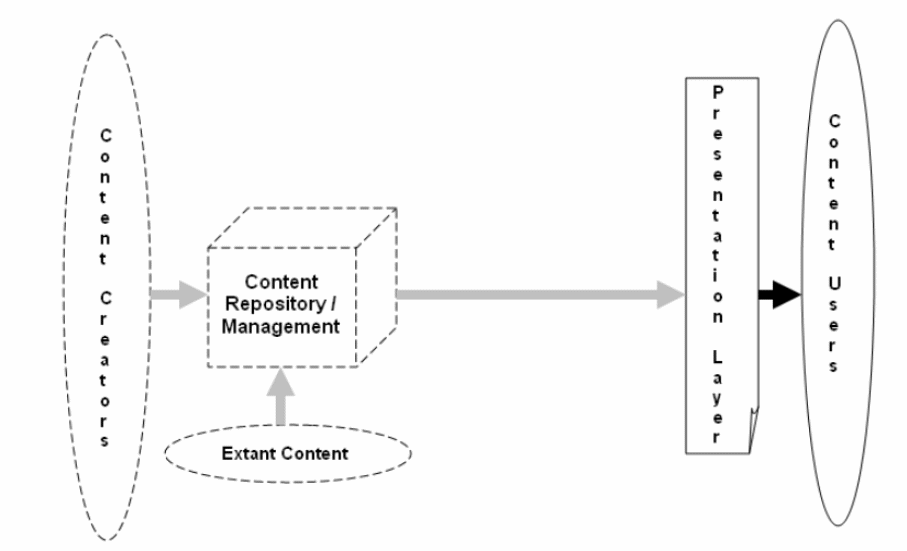
Empirical Studies
Previous studies on Learning Management System
Numerous studies have been conducted on learning management systems. Most of these studies have been carried out on K-12 schools (Tubaishat, 2008; Martin, 2009; Mizra & Al-Addulkareem, 2016) with limited studies on corporate e-learning (Spirgi & Gebavi, 2007; Chong & Besharati, 2014). Irlbeck and Mowart (2015) carried out a case study of two companies and a community college with respect to learning content management systems.
The companies included We Deliver Call Centre Ltd (a courier company based in Canada), U-learn Community College and PLG International Insurance Company. Their study concluded that LMS and CMS are suitable solutions, but their adoption depends on the needs of an organization. They found LMS to be more cost-effective and efficient than the conventional classroom learning. Besides being less expensive, the information stored in the learning management system can be easily and speedily accessed. Additionally, learners’ progress can easily be recorded and assessed (Irlbeck & Mowart, 2015).
Kelly (2009) conducted a study to compare the efficiency of Moodle and the conventional classroom learning at San Francisco State University. Moodle is an open-source web instructional system. The study targeted five tutors and 300 students, including disabled students. The study established that Moodle offers the flexibility to meet both the needs of the students and the faculty in a timely manner. Nearly all the sampled students and instructors endorsed the use of Moodle in learning.
The study recommended an exclusive usage of the LMS program in learning due to a number of factors: first, they are less costly and accessible to all persons; second, they can convey large volume of diverse content to different individuals at the same time and; last but not least, the use of technology in learning appeals to many youths, especially college students (Kelly, 2009, p. 89).
Kim et al. (2004) carried a study to determine the effect of LMS on adult education. According to the study, e-Learning courses that are created on the premise of sound instructional outlining systems and stick to adult learning standards, can be exceedingly valuable for mature learners. These mature learners, who are experienced, disciplined and expected to be more occupied, tend to be more inclined towards learning with an aim of improving their work performance. They tend to follow such courses which can permit them to try, practice, carry out, and obtain requisite aptitude
Previous Studies on LMS on Power and Energy Companies
Magd and Hamza (2012) conducted a comparative analysis of the knowledge management process and corrective action at SOFCOM LTD. SOFCOM LTD is a Saudi Arabian company dealing in oil and gas. The study concluded that quality management system plays a significant role in the establishment of knowledge management platform. According to the study, learning management system can be enhanced by combining value-added frameworks.
This simply implies to the development of an integrated management system hinged on unified evaluation concept. Therefore, successful implementation of learning management system depends on a continuous assessment of corporate strategy, structure and systems quality. This enables employees to take part in the system regardless of technical hitches that they must address (Magd & Hamza, 2012, p. 126).
Qwaider (2011), on the other hand, did a research on how power companies in the Middle East are using learning management systems to improve knowledge management. The found out that most power companies in the Middle East are using deployed solution system. Even though these systems are relatively expensive compared to hosted systems, they have been well-received by company employees. The high endorsement level is attributed to the flexibility of these systems
Gallarotti and Al Filali (2013) found out that the dwindling oil prices in the global market are making power and energy companies to be more concerned about their future. Among them is Saudi ARAMCO which has decided to invest immensely in alternative energy sources. Such changes demand new knowledge and skills. As a result, power and energy companies like ARAMCO are in the forefront in the quest for new knowledge. ARAMCO has set up a modular architectural LMS based on the state of the art technologies, which is aimed at integrating learning management system and content management system with a cloud-based software, as well as the social networking platforms (Gallarotti & Al Filali, 2013, p. 5).
Methodology
Introduction
This is the strategy of coordinating the procedures of doing the study. It is, in this manner, supportive for driving the investigation and for separating the examination addresses. Methodology demands that much care ought to be given to the sorts of processes to be followed in fulfilling a given plan or a goal (Blanchard and Cathy, 2002). The reason for this study is to make a space for further study that will survey the affiliation between identified variables and the knowledge system management. Therefore, the study is exploratory in nature. An exploratory Study gives others a chance to survey zones that have not been widely scrutinized (Saunders, Thornhill, and Lewis, 2009).
For this reason, participating in exploratory studies add extra information on the issue or marvel under scrutiny. This has been accomplished by examining the specified hypotheses. To embark on this study, a wide-ranging methodology has been assimilated, which incorporates study plan, the sample and the strategies that were utilized as a part of assembling data.
Research Design
There are three sorts of research design: an exploratory study, descriptive study and causal study (Chester 70). Exploratory research predominantly investigates on the aspect of the problem to draw deductions. In this situation, the analyst is in a decent position to comprehend the issue under scrutiny. The stream of exploratory examination includes distinguishing the issue and trying to locate the suitable arrangements and new thoughts (Chester 73). Exploratory examination is for the most part pertinent in circumstances where the structure of the research problem is not defined. The interview is a decent example of the techniques that is often utilized to accumulate data in this sort of examination (Chester 70).
Then again, descriptive study is generally pertinent in circumstances where the structure of the research problem is definite. This sort of study is utilized when the analyst hopes to differentiate the different discernable facts in a specimen or a populace (Chester 72). What’s more, descriptive study is ordinarily utilized by the scientist when the researcher has an earlier comprehension of the issue under scrutiny. The causal examination is the sort of exploration whereby there is a clear structure of the problem under study. In this situation, the scientist is intrigued to investigate the cause-impact relationship. The causes are recognized, investigated and the degree of the impacts is looked into (Chester 70).
Research Philosophy
Research philosophy alludes to the change of the exploration establishment, research data and its inclination. It is also described with the help of research paradigm. Research paradigm is the extensive structure, which contains insight, feelings, and cognizance of a couple of theories and practices that are used to lead an examination. It is depicted as a definite technique, which incorporates diverse steps through which an expert makes a relationship between the examination targets and inquiries. Paradigm is a specific perspective about coordinating an investigation. It is not by any means a system, but rather all the more a rationale that associates how the investigation is to be driven (Saunders, Thornhill, and Lewis, 2009).
Research philosophy and rationale contains distinctive variables, for instance, the perspective of an individual, his perspective, the combination of feelings towards reality, et cetera. This thought affects the feelings and estimation of the researchers, with the objective that he can give considerable arguments to give strong results. There are three sorts of the exploration paradigm. They include authenticity, positivism, and interpretivism (Saunders, Thornhill, and Lewis, 2009).
Positivism is particularly associated with objectivism. With this philosophical strategy, scientists give their point of view to survey the social world with the offer of objectivity set up of subjectivity. This suggests the investigators are captivated to accumulate general information and data from a significant social case rather than surveying inconspicuous components of the examination. As showed by this position, the investigator’s specific feelings cannot affect the investigation. The positivist philosophical approach is generally associated with the discernments and examination to accumulate numeric data (Saunders, Thornhill, and Lewis, 2009).
Interpretivism can be described as the social constructionism when concentrating on research administration. According to this philosophical approach, interpretivism offer importance to their feelings and worth to give an agreeable guard for an issue in exploration (Saunders, Thornhill, and Lewis, 2009). With the help of interpretivism, researchers focus on the genuine statistical information as demonstrated by the research problem. Interpretivism fathoms specific business condition. In this technique, experts use a sample and evaluate them in point of interest to fathom the points of view of the populace.
Authenticity (or credibility) mainly assembles the reality and feelings in nature. There are two essential procedures that focus on prompt and fundamental genuineness. Prompt reality suggests the substantial traits that a man can see, touch or feel. On the other hand, in essential genuineness, individuals fight about their experiences for a particular situation. This is associated with the condition of social constructivism, in light of the way that a man tries to exhibit his feelings and qualities (Saunders, Thornhill, and Lewis, 2009).
Quantitative and Qualitative Approach
A qualitative study, generally known as subjective exploration is a type of exploratory research (Blanchard and Cathy, 2002). It is used to get a perception of shrouded reasons, conclusions, and motivations. It gives bits of learning into the issue or makes considerations or theories for potential quantitative analysis. A qualitative study is also used to uncover designs in thought and assessments, and dive more significantly into the issue.
The subjective data collection frameworks vary using unstructured or semi-sorted out techniques. Some normal schedules include focus groups, individual gatherings, and participation or discernments. The sample size is usually small, and respondents are selected to fulfill a given share (Blanchard and Cathy, 2002).
On the other hand, quantitative exploration is used to assess an issue by a technique for creating numerical data or data that can be changed into usable bits of knowledge. It is used to assess perspectives, suppositions, hones and other described variables. In addition, it provides the results from a greater sample of the populace. Quantitative research uses quantifiable data to arrange facts and uncover plans in the study (Blanchard and Cathy, 2002). Quantitative data aggregation schedules are more sorted out than the subjective data collecting methodologies. Quantitative data gathering procedures includes diverse sorts of diagrams – online studies, paper audits, telephone interviews, longitudinal studies, webpage interceptors, online studies, and methodical observations (Blanchard and Cathy, 2002).
The primary study addresses the objective issues. The research organization has the general control of the method and the investigation is molded correspondingly as its destinations and degrees are concerned. In addition, the research organization can be requested to focus their attempts to discover information with respect to particular market instead of fixation on the mass business sector (Blanchard and Cathy, 2002).
The description of data is better in the primary investigation. The accumulated data can be examined and deciphered by the clients depending upon their requirements rather than relying upon the explanation made by powers of discretionary data. Typically, auxiliary data is never considered late and it may not be specific to the spot or condition that the client is concentrating on. Primary research has turned into a more scrupulous tool since the scientist can use data which is useful for him. The data collector in primary research is the proprietor of that information and he/she needs not to bestow it to various associations and contestants. This gives favorable position over contestants responding to discretionary information (Blanchard and Cathy, 2002).
Nevertheless, gathering data using primary investigation is a costly issue as the client must be incorporated all through and must layout everything. Because of far reaching nature of the action, the period expected to do research specifically is long when compared to secondary study, which can be assembled in much lesser time. If the investigation incorporates taking criticism, there are high dangers that information given may be wrong. Criticism by their vital nature are ordinarily uneven or given just for the purpose of it. Aside from expense and time, distinctive resources like HR and materials too are required in major studies and data gathering (Blanchard and Cathy, 2002).
Methodological Choice
This includes is the output of a progression of choices of the researcher in regards to how the study will be directed. The research design is nearly connected with the system of the study and aides making arrangements for executing the study (Blanchard and Cathy, 2002). It is an outline for directing the study that emphasizes on control over variables that could interfere with the legitimacy of the discoveries. The research designs differ as to the amount of structure the analyst forces on the examination circumstance and the amount of adaptability is permitted once the study is ongoing. Many quantitative studies have more structured research designs than qualitative studies, which have more fluid research designs.
A strategy that is regularly utilized to acquire data on social and behavioral elements and the connections between these elements is a research survey. In this case, the specialist chooses a specimen or subgroup of individuals and gets some information about issues identified with the examination. The responses to these inquiries are then viewed as a depiction distinguishing the suppositions and states of mind of the entire populace from which the example was taken.
The study will adopt a descriptive research design or an exploratory research design. Depiction can be a noteworthy motivation behind both subjective and quantitative explorations. The descriptive research design enables the specialist to acquire data regarding any phenomenon. Exploratory studies give an inside and out an investigation of a solitary procedure. On the other hand, the descriptive research design analyses the attributes of a particular populace.
Both exploratory research design and descriptive research design start with the problem statement. Exploratory study goes for researching the research problem, the way in which it is showed, and alternate components with which it is connected. An exploratory research design is embraced when another zone or theme is being researched.
Research Strategy
The study will adopt a case study approach. A case study (or a contextual analysis) examination incorporates a nearby and point by point investigation of a subject (the case), as well as its related sensible conditions. Contextual examinations appear with amazing recap all through renowned works. Just about anyone with training can put forth a defense for having done a relevant examination at some point or another in their life. Relevant investigations also can be conveyed by taking after a formal investigation strategy (Noor 2008, p.1603).
The consequent arrangement of contextual examination has long had a distinctive spot in various orders and callings, reaching out from science, humanities, human science, and political science to training, restorative science, social organization, and administrative science. In carrying out a contextual examination, the “case” being focused on might be an individual, association, event, or exercise, existing at a specific point (Noor 2008, p.1603).
For example, therapeutic science has conveyed both comprehended contextual examinations of individuals and relevant investigations of medicinal practices. Regardless, when “case” is used as a part of a dynamic sense, as for a situation, a suggestion, or a dispute, such a case can be the subject of various investigation schedules, not just relevant examination research (Noor 2008, p.1604).
One methodology sees the contextual investigation described as an examination method, a precise solicitation that analyzes an issue within its veritable setting. Contextual examination can mean single and different logical examinations. It can likewise fuse quantitative verification and relies upon various wellsprings of affirmation; the methodological benefit from the previous progression of theoretical proposals. In light of current circumstances, contextual examination should not to be mixed up for subjective investigation, as logical examinations can be established on any mix of quantitative and subjective data. Meanwhile, the constant trials can give a real structure to making instigations from quantitative data (Noor 2008, p.1606).
Population and Sampling
The overall collection of items that fulfill a dispensed arrangement of criteria is called a population. There is a disparity between the target populace and the existing populace. The target populace includes every one of the subjects about which the researcher might want to make conjectures. The existing populace involves every one of the cases that conform to the assigned criteria and are open to the researcher.
The process of picking population sample to reflect the entire population is sampling (Saunders, Thornhill, and Lewis, 2009). Exploratory design requires a small sample to reflect the entire populace. In subjective exploration, individuals are selected to take part in the study bearing in mind their direct experience of the problem under study (Saunders, Thornhill, and Lewis, 2009). In keeping with this study, the population comprised of the personnel of the organization under study.
Purposive sampling was utilized in this study. This is a non-probability sampling technique. Despite the fact that this method expands the likelihood of population samples that do not represent the whole population, it is simple to reach all the respondents. Since it was hard to access the official registers or records containing the names of the workers, the researcher chose to utilize snowball testing to distinguish the respondents.
Purposive sampling and snowball testing are linked and have a common aspect: a suitable sample is selected at an appropriate. Snowball testing is imperative in subjective study since it is synchronized by individuals that are difficult to differentiate (Saunders, Thornhill, and Lewis, 2009). In snowball testing, the researcher collects information on a number of individuals from the objective populace he can discover and after that seeks for data from those individuals that enable him/her to categorize the population accordingly. Such strategies enable the researcher to select specific subjects who will give the broadest data about the problem statement.
Data Collection and Instrumentation
The researcher used questionnaires to collect data. A total of 200 questionnaires were filled by the respondents. The questions in the questionnaire are available in Appendix 1. This study technique corroborates the need to minimize the cost of the research. This is due to the fact that respondents are physically detached (Saunders, Thornhill, and Lewis, 2009).
Questionnaire Survey
Questionnaires are pre-composed course of events requesting respondents to record their reactions. Questionnaires can be utilized to contact the respondents either through the letters or in person. Before delineating a study, there are three measures to consider, namely benchmarks of wording, standards of estimation, and the general set-up of the study. The guideline of the content incorporates the content and reason for the solicitation.
For example, the researcher needs to comprehend the technique for variables to be tapped. In case a variable is subjective, for example, where a respondent’s conviction, observations, and points of view are to be measured, the request ought to draw the estimations and parts of the considerations. Additionally, where target variables, for instance, age and pay are tapped, a solitary direct question would be appropriate (Saunders, Thornhill, and Lewis, 2009).
The wording and language are unmistakable components of this rule, for example, the overview ought to assess the viewpoint of the respondent. In this manner, the decision of words ought to rely upon the guideline. The principle of estimation includes the models to be utilized to guarantee that the information gathered is fitting to test the speculations (Saunders, Thornhill, and Lewis, 2009).
Data Analysis and Presentation
The gathered information was examined quantitatively. This was accomplished by using quantitative data examination instruments. Considering the way that the study has included the quantitative exploration design, the information investigation and presentation strategy involved the appropriation of the printed presentation system. The strategy was executed by utilizing articulations that contain numerals. One of the printed presentation instruments that were utilized as a part of dissecting the information incorporates the Likert scale. By utilizing this instrument, the examination was in a position to assess the information utilizing point scales.
Notwithstanding the above method, the exploration also involved the use of SPSS break down. The use of SPSS assumed a crucial part in enhancing the viability and proficiency with which the gathered information was dissected. Additionally, SPSS examination assumed a key part in enhancing the simplicity with which the exploration information was translated.
Ethical considerations
Just before the study was directed, the researcher initially built up a proposition and submitted it for endorsement. The proposition involved the review and the objectives of the study. Moreover, the proposition involved how the respondents of the examination would be enrolled and taken care of. The responses of the respondents will be treated with secrecy so as to uphold the wellbeing and the right to privacy of the respondents. Once the endorsement was given, the researcher proceeded to direct the examination while holding fast to the stipulated rules (Saunders, Thornhill, and Lewis, 2009).
Research limitation
The cost of conducting the survey was expensive. Also, there were instances when the respondents provided false and incorrect responses. The process of data collection was time-consuming and tedious. What’s more, a few company representatives were hesitant to offer some data that was private and perilous in the hands of their rivals. This translated to an extraordinary test in the examination as the researcher needed to take more time to find workers who would willingly give out sufficient data.
Conclusion
This chapter has provided the outline of the study process, approach and design. Since the research involved a case study, the researcher adopted an exploratory approach. The study also adopted a positivist approach to reassess the existing studies on the same. In addition, a qualitative approach was preferred over quantitative approach because it captures all the variables, thereby, producing reliable results. There were potential limitations of this study in the area of reliability and validity. However, they were minimized by the use of suitable research strategies and processes. Ethical issues affecting this study process are highlighted with appropriate mitigation in place whenever a breakdown occurs.
Findings, data analysis and interpretation
Introduction
This area covers data analysis, presentation and elucidation. The study outcomes were analysed using SPPS computer package, paying much attention on regression and correlation analysis.
Characteristics of the sample
In order to comprehend the demographic information of the participants, the distribution of gender, age, education level, income, and the number of years employed in the business are summarized in the following sections.
Gender
Table 1: Gender distribution.
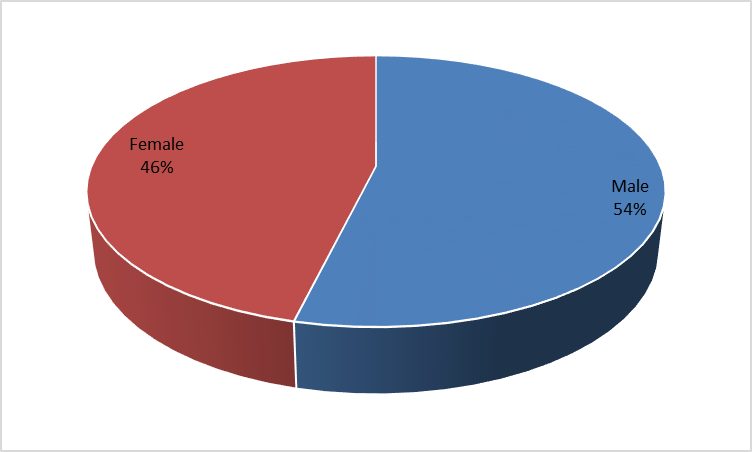
The distribution of gender is summarized in table 1 and figure 1, according to the results there are 92 females and 106 males, composed 46% and 54% of the sample respectively.
Age
Table 2: Age distribution.

The distribution of age is summarized in table 2 and figure 2 above. According to the results, there are 20% of the participants aged between 26 and 35, which is the largest proportion, followed by participants aged between 36 and 45, composed 50% of the sample, and participants aged between 46 and 55, accounted 30% of the sample. Finally, participants aged above 55 or between 18 and 25 composed 10% and 5% of the sample respectively.
Education level
Table 3: Education distribution.
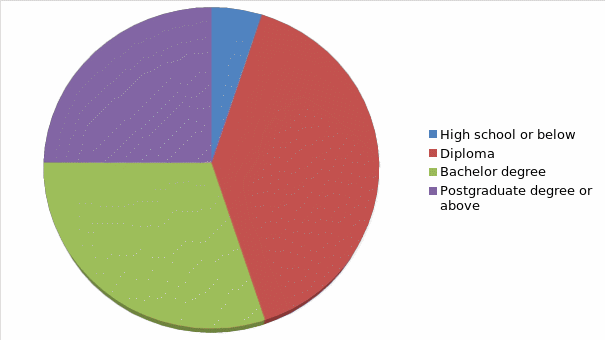
In terms of the education level, over half of the participants (55%) have a degree or postgraduate degree, which is the largest proportion, followed by participants who have a diploma, composed 40% of the sample. There are only 5% of the participants have high school or below degree.
Income
Table 4: Income distribution.
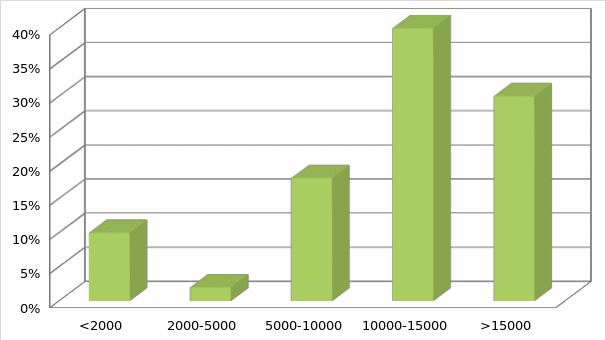
Regarding the income of the participants, 40% of the participants indicate that they have income between 10000-15000, which is the largest proportion, followed by participants who have income above 15000, composed 30% of the sample, and participants who have income between 5000-10000, composed 36% of the sample. About 10% of the participants have income below 2000 and 2% of the participants have income between 2000 and 5000.
The number years of employment
Table 5: Number of years employed.
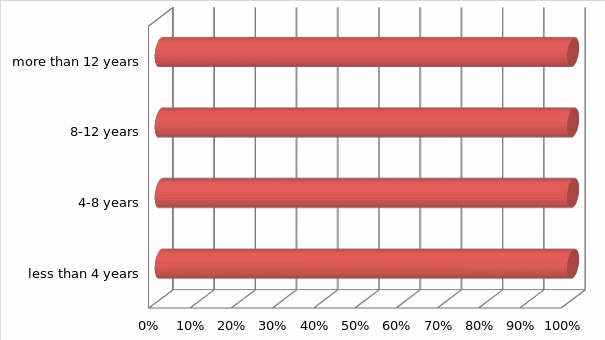
Table 5 and figure 5 above summarized the number of years that the participants have been employed. According to the results, 33% of the participants have stayed more than 12 years, which is the largest proportion, followed by participants who have stayed between 8 and 12 years, composed 24% of the sample, and participants who have stayed between 4 and 8 years, composed 22% of the sample. In addition, there are 42 participants have stayed in employment for less than 4 years, composed 21% of the sample.
Reliability Analysis
Reliability analysis is frequently used to assess whether the various instrument items are gauging the similar variable or concept. In SPSS, the Cronbach’s Alpha value is usually used to gauge the reliability of the numerous variables. The least requirement for the value of Cronbach’s Alpha is 0.7 to guarantee that the items are internally reliable and unswerving. In an investigative study, the Cronbach’s Alpha value of 0.6 can also be accepted.
In this research, the various measurement items are adopted from previous studies, thus, the minimum value is set as 0.7. The corrected-item total correlation (CITC) is also incorporated to assess the dependability of particular item. If the CICT is underneath 0.5, then the item cannot dependably gauge the resultant variable and should be omitted from other analysis. The Cronbach’s Alpha for variables is summarized in the table below.
Table 6 Reliability Analysis for Variables.
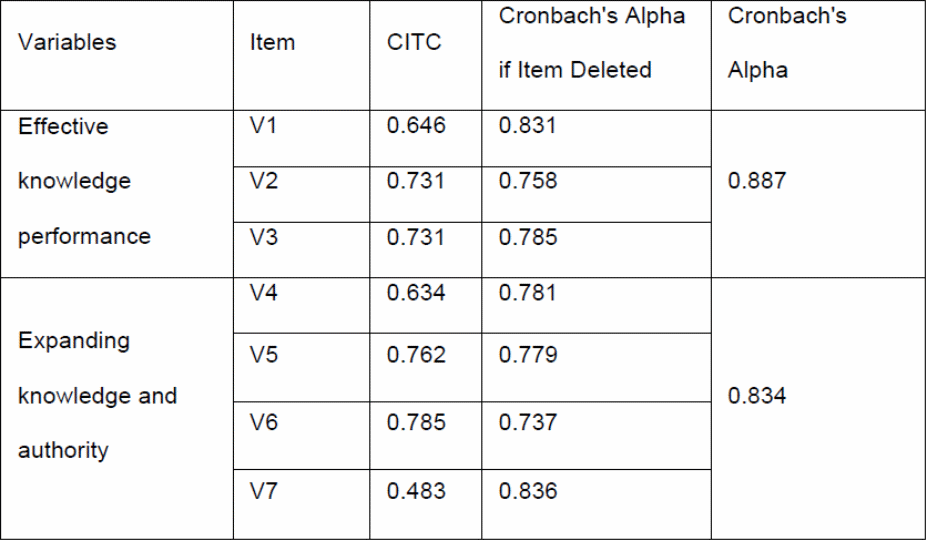
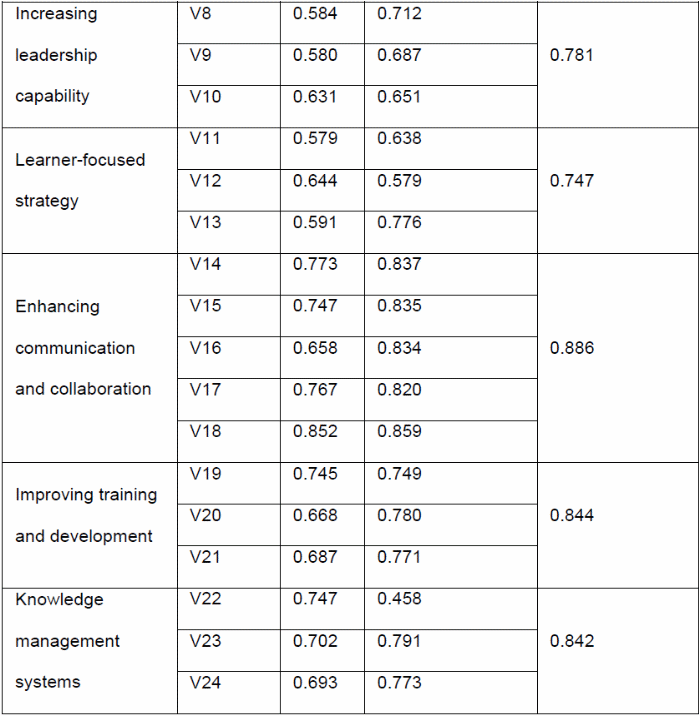
According to the results, the Cronbach’s alpha value for effective knowledge performance, expanding knowledge and authority, increasing leadership capability, learner-focused strategy, enhancing communication and collaboration, improving training and development, and knowledge management systems are 0.887, 0.834, 0.781, 0.747, 0.886, 0.844, and 0.842, which are all above the minimum requirement of 0.7. Furthermore, the corrected-item total correlation for specific items are all exceeding the least requirement of 0.5 and the Cronbach’s Alpha if scrapped for specific items are all beneath the Cronbach’s Alpha value. These outcomes show that these items are internally reliable and consistent, and can be utilized for more analysis.
Frequency analysis
Effective knowledge performance frequency analysis
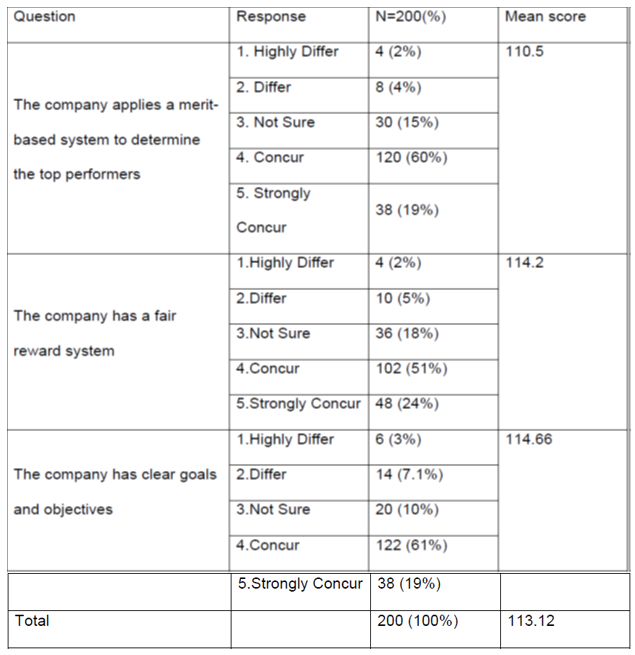
As shown in table 7 above, more than half of the respondents are acquainted with the effective knowledge performance. There are 69% of the respondents indicate that “the company applies a merit-based system to determine the top performers” and 75% of the respondents indicate that “the company has a fair reward system”. From the total score of these 3 items measuring effective knowledge performance, a large group of respondents have a score of 111 or 114.
To gain a clearer picture of the respondents’ effective knowledge performance, the items measuring effective knowledge performance were aggregated. The aggregate mean score is classified into three levels: low (below 50), medium (50-100), and high (100 and above). The aggregated mean value was 113.12, suggesting that respondents have high level perception of measuring effective knowledge performance.
Expanding knowledge and authority frequency analysis
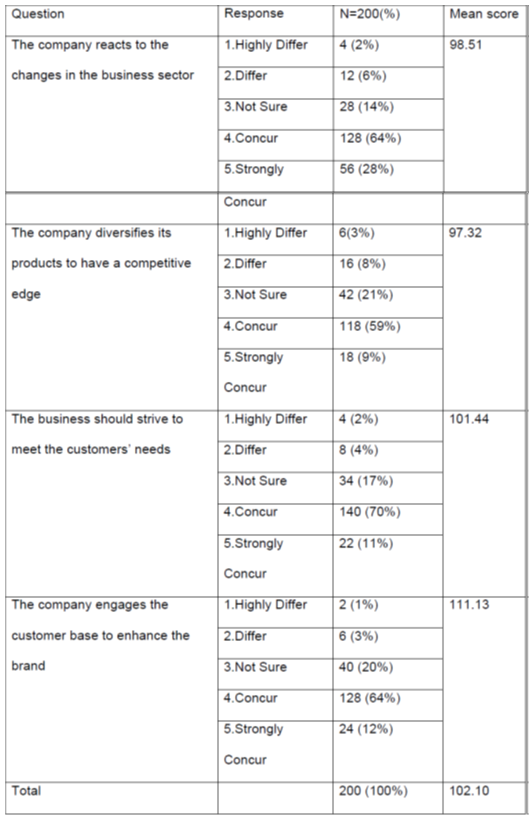
Table 8 shows the overall responses to the expanding knowledge and authority among Respondents. According to the results, the mean value for all measurement items was between 97 and 112. Thus, the respondents’ attitude concern was at a high level. By analyzing the frequency, it can be seen that more than half of the respondents have expressed their concern regarding expanding knowledge and authority.
The aggregate mean score was 102, suggesting a high level of expanding knowledge and authority. The overall scores from the items measuring the variable ‘expanding knowledge and authority’ were summarized, and it is found that the range was 15, with scores ranging from 97 and 112. The majority of the Respondents have an overall score between 98 and 112.
Increasing leadership capability frequency analysis
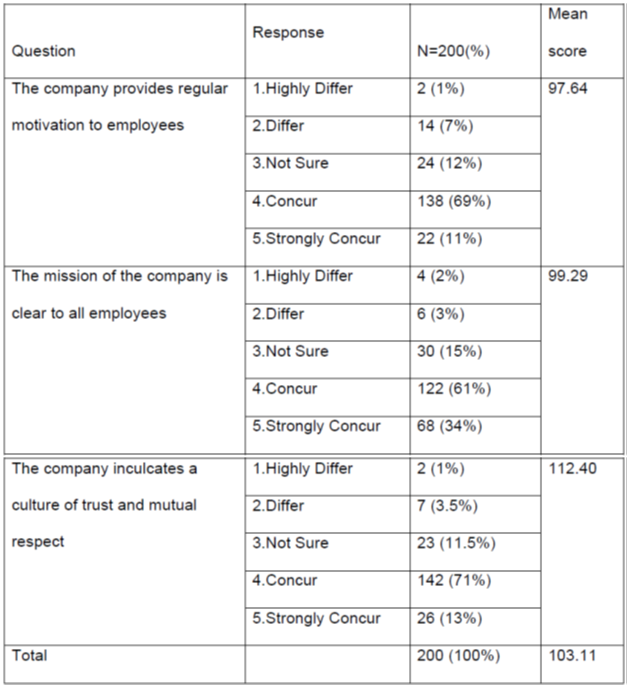
Table 9 summarized the frequency analysis for items measuring increasing leadership capability. According to the results, a majority of the respondents concur or strongly concur that “the company provides regular motivation to employees”, the mission of the company is clear to all employees”, and “the company inculcates a culture of trust and mutual respect”. The aggregated mean value of increasing leadership capability is 103.11, suggesting that respondents have a positive attitude towards the increasing leadership capability factors of the business. As can be seen from the results, the majority of the score ranged between 99 and 104, indicating a relatively higher level positive attitude towards ‘increasing leadership capability’.
Learner-focused strategy frequency analysis
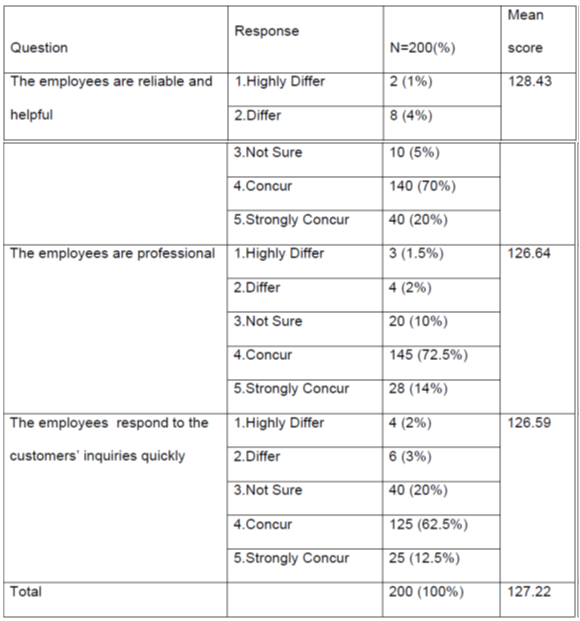
Table 10 summarized the frequency analysis for items measuring learner-focused strategy. According to the results, more than half of the respondents concur or strongly concur that “the employees are reliable and helpful”, “the employees are professional”, and “the employees respond to the customers’ inquiries quickly”. The aggregated mean value of learner-focused strategy is 127.22, suggesting that learner-focused strategy is at a high level. As can be seen from the outcomes, the majority of the score ranged between 126 and 129, which also indicate a high-level learner-focused strategy perception.
Enhancing communication and collaboration frequency analysis
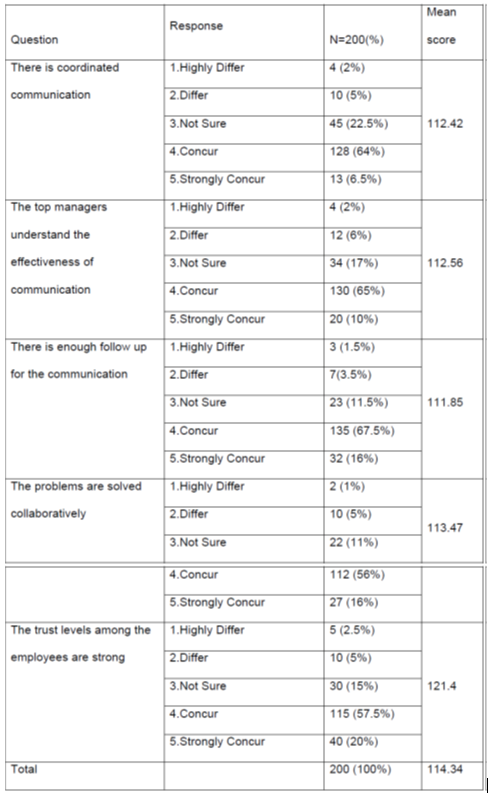
Table 11 summarized the frequency analysis for items measuring enhancing communication and collaboration. According to the results, more than half of the respondents concur or strongly concur that “there is coordinated communication”, “the top managers understand the effectiveness of communication”, “there is enough follow up for the communication”, “the problems are solved collaboratively”, and “the trust levels among the employees are strong”.
The aggregated mean value of enhancing communication and collaboration is 114.34, suggesting that enhancing communication and collaboration is at a high level. As can be seen from the results, the majority of the score ranged between 112 and 114, which also indicate a high-level of the perception on enhancing communication and collaboration.
Improving training and development frequency analysis
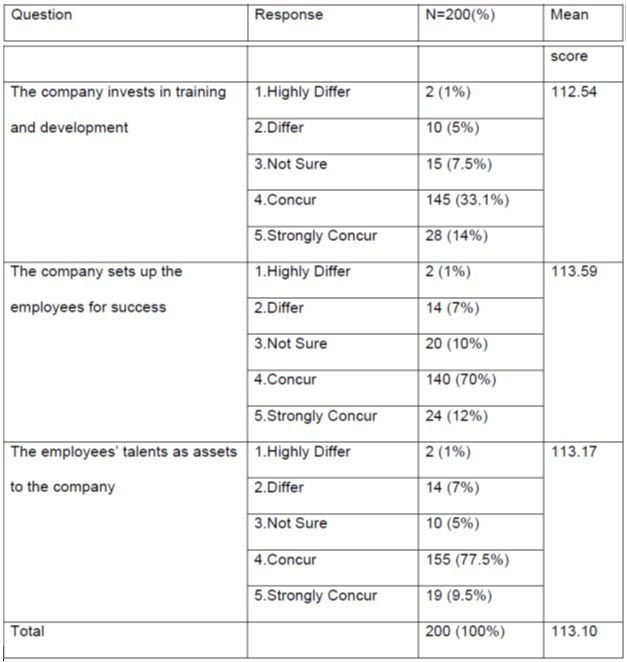
Table 12 summarized the frequency analysis for items measuring improving training and development. According to the results, more than half of the respondents concur or strongly concur that “the Company invests in training and development”, “the company sets up the employees for success”, “the employees’ talents as assets to the company”. The aggregated mean value of improving training and development is 113.10, suggesting that the improving training and development is at a high level. As can be seen from the outcomes, the majority of the score ranged between 112 and 114, which also indicate a high level improving training and development perception.
Summary of Descriptive statistics
Descriptive statistics using the measures of central tendencies were computed from the results gathered from the questionnaires. The questionnaires focused on the elements that power and energy companies in Saudi Arabia utilize to enhance knowledge management system.
Summary of Results
Respondents who were majorly employees of an energy company in Saudi Arabia which is well-known for successful implementation of knowledge management system were issued with questionnaires in order to express their responses regarding the initiatives that the company was undertaking to enhance knowledge management system. The summary of the results is in table 6 below.
The results show that from the sample of 200 respondents, the mean for effective knowledge performance is 113.20 with a standard deviation of 14.30. From this computation, it can be deduced that effective knowledge performance has a significant impact on knowledge system management; this is indicated by the higher value of the standard deviation. In addition, the calculated arithmetic means for improving training and development, enhancing communication and collaboration, effective knowledge performance, increasing leadership capability, and expanding knowledge and authority is less than the calculated arithmetic mean for learner-focused strategy.
It is, therefore, evident that learner-focused strategy has more impact on knowledge system management than other existing initiatives. Learner-focused strategy (Mean=127.22, SD=15.31) is more effective than addressing it through enhancing communication and collaboration (Mean=114.34, SD=14.23), increasing leadership capability (Mean=103.11, SD=10.81), effective knowledge performance (Mean=113.12, SD=14.29), improving training and development (Mean=113.10, SD=14.27), and expanding knowledge and authority (Mean=102.10, SD=11.28).
Table 6: Summary of the descriptive statistics.
Inferential statistics
The results of inferential statistics were used to establish the relationship that exists among the initiatives that the company was undertaking and the knowledge system management; inferential statistics was utilized to establish the link among the variables. The results are summarized in Table 7 below.
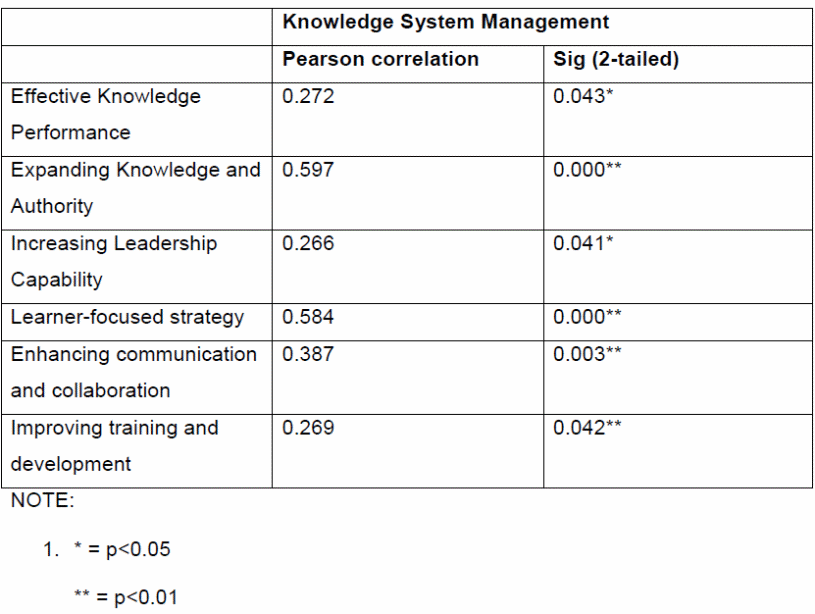
The results in the table above demonstrate that there are major correlations between expanding knowledge and authority and the knowledge system management (r = 0.594, p < 0.01), learner-focused strategy and the knowledge system management (r = 0.584, p < 0.01), enhancing communication and collaboration and the knowledge system management(r = 0.387, p < 0.01), between increasing leadership capability and the knowledge system management (r = 0.266, p < 0.05), and improving training and development and the knowledge system management(r = 0.272, p < 0.05). There was also a significant relationship between effective knowledge performance and the knowledge system management (r = 0.272, p < 0.05).
A regression analysis to analyse how the variables predict the employees’ resistance was done and the results are summarized in Table 4.3 below.
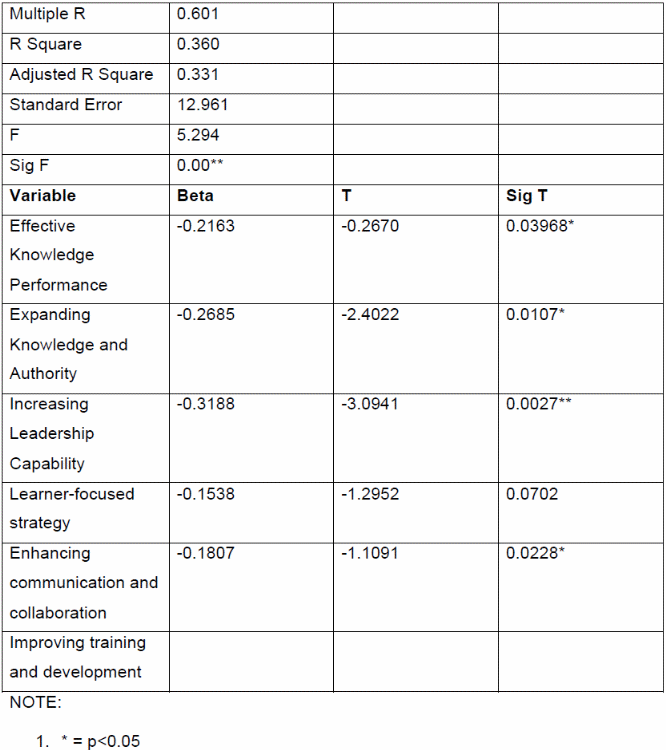
The result established that the multiple R-value is 0.601. The R-Square value of 0.360 indicates that 36% of the variables explained the dependent variable. The F-statistic (5.294) is statistically significant at 0.01 level; meaning that the independent variables significantly enlighten 36% of the variance in addressing the knowledge system management. Increasing leadership capability is the best predictor of the knowledge system management as it has a beta coefficient value of -0.3188 and is statistically significant at the 0.01 level. In addition, expanding knowledge and authority, effective knowledge performance, and enhancing communication and collaboration are statistically significant at 0.05.
The negative value of the beta coefficient of enhancing communication and collaboration indicates that the knowledge management system in energy companies is very critical than other companies operating in different industries. In the same manner, the negative beta value of improving training and development, , effective knowledge performance, increasing leadership capability, learner-focused strategy, and expanding knowledge and authority show that they have a significant impact on the implementation of knowledge management system.
Conclusion and recommendations
Introduction
This part demonstrates the outline of the revelations and examination of the results in comprehension to the objectives of this study. Finally, the segment contains the conclusions and recommendations.
Conclusion
The last one hundred years saw Information Communication Technology (ICT) turning out to be a core service enabler. The “dot.com” recession of 2001 followed by the Great Recession of 2007, saw an increasing demand for information technology systems to maintain a competitive advantage at a low cost. At the same time, Technology and connectivity evolved very fast with the introduction of numerous electronic platforms and high-speed internet. From a narrow perspective, it is difficult to assess the impact of these technologies since they have transformed how individuals and institutions operate. The continuous evolution of ICT has helped companies to come up with new systems and discover new ways of delivering service to the consumers.
Knowledge management system is one of the systems that have been developed by organizations to help in the acquisition and delivery of information. The system also assists in assembling, assessing and sharing of information among the employees and the management. In addition, knowledge management system plays a significant role in organizational learning and development. As a result, many companies are undertaking numerous initiatives to improve the system, which include enhancing communication and collaboration, learner-focused strategy, and expanding knowledge and authority among others.
In our case, the company was involved in the following activities and practices to improve its knowledge management system: enhancing communication and collaboration, effective knowledge performance, increasing leadership capability, learner-focused strategy, and expanding knowledge and authority. The results of the study show that these initiatives had a high level of impact on knowledge system management. Among these initiatives, learner-focused strategy had the highest impact on knowledge system management with a mean value of 127.22 and standard deviation of 15.31. Expanding knowledge and authority and increasing leadership capability had the lowest score. Nonetheless, all the above mentioned variables had a very high influence on the dependent variable of knowledge system management.
The study outcomes also show that the knowledge system management in the company had a significant positive correlation with these variables. Increasing leadership capability is the best predictor of the knowledge system management as it has a beta coefficient value of -0.3188 and is statistically significant at the 0.01 level. The negative value of the beta coefficient of enhancing communication and collaboration indicates that the knowledge management system in energy companies is very critical than other companies operating in different industries. It should be remembered that energy companies operate in a knowledge-intensive industry.
Moreover, information and communication departments are in charge of keeping up with the latest innovation patterns and devising novel tools and frameworks available to the organization.
The execution of effective performance management is among the variables that have a great impact on knowledge management systems. Be that as it may, many organizations still focus on inflexible, old-fashioned management strategies. The top performing organizations, however, focus on performance that uses a fair procedure to reward the top performers. They also convey the organizational goals appropriately to the employees. These elements promote equity and inclusiveness in the organization. Expanding knowledge and authority enables the companies in Saudi Arabia to reinforce the empowerment levels in all the sections of the organizations hierarchy.
In a company characterized by lack of trust and accountability, there are low levels of empowerment and authority. A higher level of empowerment and accountability enables the organization to inculcate an innovative and adoption of e-learning among the workforce and develop a strong relationship with the clients in order to stimulate product diversification and improve the consumers’ experiences. In addition, employee empowerment and accountability helps in developing learning tools and management of digital contents through innovation, hence reinforcing knowledge management systems.
In organizations where the employee engagement is higher through enhanced leadership capabilities, the mission is shared among all the employees regardless of their positions in the hierarchical level. The top management offers inspiration and motivation to the employees through constant communication. The top managers also inculcate a philosophy of trust and all the employees are incorporated in the development of the business strategies, which include e-business and e-learning. It is only through leadership capabilities that the organization will streamline its visions and goals with the current knowledge and state of the art technologies.
Effective knowledge performance is a significant element in the success of e-learning since it emphasizes on ingenuity and novelty. This shows that effective knowledge performance impacts the means by which ingenious and groundbreaking solutions are promoted. In other words, it is the core of competitive advantage, especially when it is linked to sustainable high performance.
Increased knowledge and authority calls for a comprehensive transformation in all facets of human activities, for instance, global view, social values, technical knowhow, and authority among others. In short, increased knowledge and authority basically refer to all actions that strive for a balance in the course of relations between the organization and its employees.
The organization should be able to empower its employees in a way that they can be able to express themselves fully without badly and irrevocably impacting the holding capability of the shareholders and the surroundings on which the organization hinges. The knowledge and authority contribute towards the attainment of organizational goals or objectives through innovation and novelty.
The use of new technologies in the management of knowledge often leads to proficient and compelling solutions. However, whereas the technology and instruments might be accessible, the usage and incorporation into the organization’s values and principles is a process that requires an organizational learning curve on the off chance that individuals in the organization are not familiar with this sort of learning. In addition, the adoption and implementation of knowledge management systems demand self-discipline and self-motivation on the part of employees so as to enjoy the full benefits of e-learning.
Recommendations
This study provides information that is pertinent to knowledge management systems. A lot of emphases should be put on the learner-focused strategy. The study found that learner-focused strategy has the greatest impact on knowledge management system, especially in the energy companies. Communication and collaboration should be improved so as to give an easy time for the implementation and adoption of e-learning. Improved training and development and leadership capability amenities should also be given a lot of priority so that they can be up to standard and fit the specifications and the requirements of the organization. Last but not least, organizations should have an extremely entrenched values and principles of learning and development to pinpoint the impact of the new system of learning.
References
Archambault, L. (2010). Identifying and addressing teaching challenges in k-12 online environments. Distance Learning, 7(2), 13-17.
Blanchard, K., & Cathy, T. (2002). The Generosity Factor: Discover the Joy of Giving Your Time, Talent, and Treasure. Oxford: Oxford University Press.
Chester, B. (1938). Functions of the Executive. Cambridge: Harvard University Press.
Chong, C. W., & Besharati, J. (2014). Challenges of knowledge sharing in the petrochemical industry: Knowledge Management & E-Learning. An International Journal, 6(2), 171-187.
Chu, Hui-Chun. (2013). Potential Negative Effects of Mobile Learning on Students’ Learning Achievement and Cognitive Load—A Format Assessment Perspective. Tokyo: Education Technology and Society.
Coates, H. (2007). A Model of Online and General Campus-Based Student Engagement. Assessment & Evaluation in Higher Education, 32(2), 121-141.
Gallarotti, G., & Al Filali, Y. (2013). Smart Development: Saudi Arabia’s Quest for a Knowledge Economy. Middletown, Connecticut: Wesleyan University.
Glushko, R., & McGrath, T. (2005). Document Engineering: Analyzing and Designing Documents for Business Informatics and Web Services. Massachusetts: MIT Press.
Gorelik, E. (2013). Cloud Computing Models. Cambridge: Massachusetts Institute of Technology.
Irlbeck, S., & Mowart, J. (2015). Learning Content Management Systems. Capella University.
Kelly, K. (2009). San Francisco State University Case Study: An Open Source Solution. San Francisco, California: University Press.
Kim, K., Hagedorn, M., Williamson, J. & Chapman, C. (2004). Participation in adult education and lifelong learning: 2000-01. New York: Free Press.
Magd, H., & Hamza, S. (2012). A Proposed Knowledge Management System in SOFCOM: Saudi Arabia Perspectives. Nang Yan Business Journal, 1 (1), 119-128.
Martin, J. (2009). Developing course material for online adult instruction. Merlot Journal of Online Learning, 5(2), 3-20.
Mauthe, A., & Thomas, P. (2004). Professional Content Management Systems: Handling Digital Media Assets. New York: John Wiley & Sons.
McDermott, R. (1999). Why information technology aspired but cannot deliver knowledge management. California Management Review, 41(4), 103-117.
Mizra, A., & Al-Addulkareem, M. (2016). Models of e-learning adopted in the Middle East. Applied Computing and Informatics, 9 (2), 83-93.
Noor, K. B. (2008). Case Study: A strategic Research Methodology. American Journal of Applied Sciences, 5 (11), 1602-1604.
Papastergiou, M. (2006). Course Management Systems as Tools for the Creation of Online Learning Environments. International Journal on E-Learning, 5(4), 593-622.
Qwaider, W. (2011). Integrated Knowledge Management and E-Learning System. International Journal of Hybrid Information Technology, 4 (4), 59-69.
Rashty, D. (2009). Traditional Learning Vs. E-learning. Web.
Robertson, J. (2003). Where is the knowledge in a content management system? Web.
Rockley, A. (2002). Managing Enterprise Content: A Unified Content Strategy. New Riders Press
Rosenberg, M. J. (2001). E-Learning: Strategies for delivering knowledge in the digital age. New York: McGraw-Hill.
Saunders, M., Lewis, P., & Thornhill, A. (2007). Study Methods for Business Students (4th ed). London: Prentice Hall.
Serban, A. M., & Luan, J. (2002). Knowledge Management: Building a Competitive Advantage in Higher Education. Institutional Research Journal, 4, (113-120.
Schein, E. H. (1993). On dialogue, culture and organizational learning. Organizational dynamics, 22(2), 40-51.
Spirgi, H. & Gebavi, A. (2007). Growing a viable LMS governance model. Chief Learning Officer, 6(8), 34-37.
Tubaishat, A. (2008).Adoption of Learning Technologies to Alleviate the Impact of Social and Cultural Limitations in Higher Education: Proceedings of the 1st E-Learning Excellence Forum (pp. 40-50). Dubai, UAE.
Tucci, C. (2013). Business model innovation. Oxford: Oxford University Press.
Vera, D. & Crossam, M. (2003). Organizational learning and knowledge management: Toward an integrative framework, in The Blackwell Handbook of Organizational Learning and Knowledge Management. Blackwell Publishing, Oxford.
Wagner, W. (2009). Using SPSS for social statistics and research methods. London, UK: SAGE Publications Ltd.
Zikmund, W. (2003). Business research methods. New York: Thomson South Western.